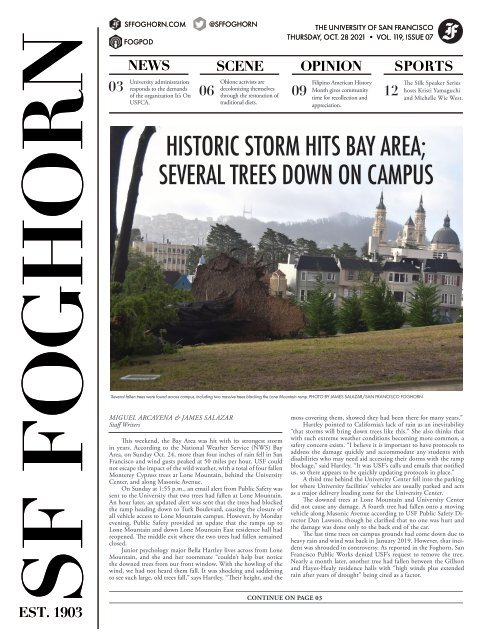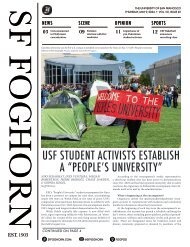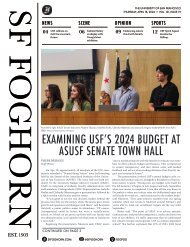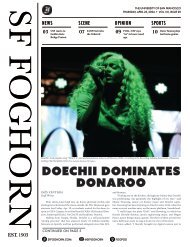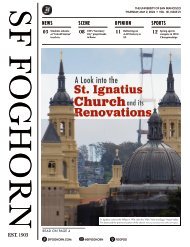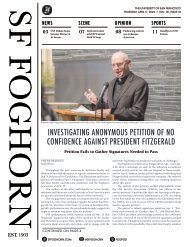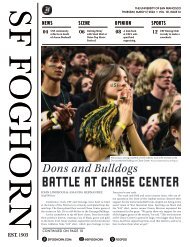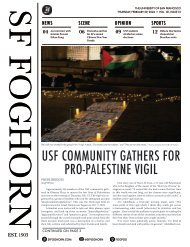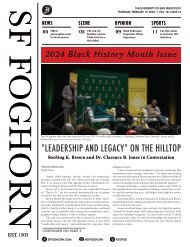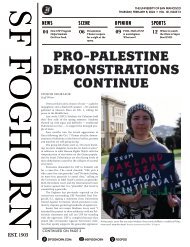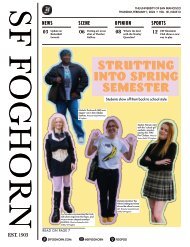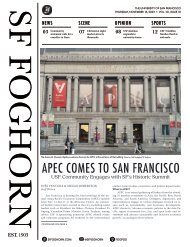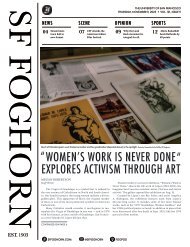VOL 119, Issue 7—Oct. 28, 2021
You also want an ePaper? Increase the reach of your titles
YUMPU automatically turns print PDFs into web optimized ePapers that Google loves.
SF FOGHORN<br />
EST. 1903<br />
03<br />
SFFOGHORN.COM<br />
FOGPOD<br />
NEWS<br />
University administration<br />
responds to the demands<br />
of the organization It’s On<br />
USFCA.<br />
MIGUEL ARCAYENA & JAMES SALAZAR<br />
Staff Writers<br />
@SFFOGHORN<br />
THE UNIVERSITY OF SAN FRANCISCO<br />
THURSDAY, OCT. <strong>28</strong> <strong>2021</strong> • <strong>VOL</strong>. <strong>119</strong>, ISSUE 07<br />
SCENE OPINION SPORTS<br />
Ohlone activists are<br />
Filipino American History<br />
decolonizing themselves<br />
Month gives community<br />
06 09 12<br />
through the restoration of<br />
traditional diets.<br />
This weekend, the Bay Area was hit with its strongest storm<br />
in years. According to the National Weather Service (NWS) Bay<br />
Area, on Sunday Oct. 24, more than four inches of rain fell in San<br />
Francisco and wind gusts peaked at 50 miles per hour. USF could<br />
not escape the impact of the wild weather, with a total of four fallen<br />
Monterey Cypress trees at Lone Mountain, behind the University<br />
Center, and along Masonic Avenue.<br />
On Sunday at 1:55 p.m., an email alert from Public Safety was<br />
sent to the University that two trees had fallen at Lone Mountain.<br />
An hour later, an updated alert was sent that the trees had blocked<br />
the ramp heading down to Turk Boulevard, causing the closure of<br />
all vehicle access to Lone Mountain campus. However, by Monday<br />
evening, Public Safety provided an update that the ramps up to<br />
Lone Mountain and down Lone Mountain East residence hall had<br />
reopened. The middle exit where the two trees had fallen remained<br />
closed.<br />
Junior psychology major Bella Hartley lives across from Lone<br />
Mountain, and she and her roommate “couldn’t help but notice<br />
the downed trees from our front window. With the howling of the<br />
wind, we had not heard them fall. It was shocking and saddening<br />
to see such large, old trees fall,” says Hartley. “Their height, and the<br />
time for recollection and<br />
appreciation.<br />
The Silk Speaker Series<br />
hosts Kristi Yamaguchi<br />
and Michelle Wie West.<br />
HISTORIC STORM HITS BAY AREA;<br />
SEVERAL TREES DOWN ON CAMPUS<br />
Several fallen trees were found across campus, including two massive trees blocking the Lone Mountain ramp. PHOTO BY JAMES SALAZAR/SAN FRANCISCO FOGHORN<br />
CONTINUE ON PAGE 03<br />
moss covering them, showed they had been there for many years.”<br />
Hartley pointed to California’s lack of rain as an inevitability<br />
“that storms will bring down trees like this.” She also thinks that<br />
with such extreme weather conditions becoming more common, a<br />
safety concern exists. “I believe it is important to have protocols to<br />
address the damage quickly and accommodate any students with<br />
disabilities who may need aid accessing their dorms with the ramp<br />
blockage,” said Hartley. “It was USF’s calls and emails that notified<br />
us, so there appears to be quickly updating protocols in place.”<br />
A third tree behind the University Center fell into the parking<br />
lot where University facilities’ vehicles are usually parked and acts<br />
as a major delivery loading zone for the University Center.<br />
The downed trees at Lone Mountain and University Center<br />
did not cause any damage. A fourth tree had fallen onto a moving<br />
vehicle along Masonic Avenue according to USF Public Safety Director<br />
Dan Lawson, though he clarified that no one was hurt and<br />
the damage was done only to the back end of the car.<br />
The last time trees on campus grounds had come down due to<br />
heavy rain and wind was back in January 2019. However, that incident<br />
was shrouded in controversy. As reported in the Foghorn, San<br />
Francisco Public Works denied USF’s request to remove the tree.<br />
Nearly a month later, another tree had fallen between the Gillson<br />
and Hayes-Healy residence halls with “high winds plus extended<br />
rain after years of drought” being cited as a factor.
02<br />
THURSDAY<br />
OCT. <strong>28</strong>,<br />
<strong>2021</strong><br />
STAFF<br />
SUBMISSION POLICY<br />
The San Francisco Foghorn is the<br />
official student newspaper of the<br />
University of San Francisco and is<br />
sponsored by the Associated Students<br />
of the University of San Francisco<br />
(ASUSF).<br />
The thoughts and opinions expressed<br />
herein are those of the individual writers<br />
and do not necessarily reflect those<br />
of the Foghorn staff, the administration,<br />
the faculty, staff or the students<br />
of the University of San Francisco.<br />
Contents of each issue are the sole<br />
responsibilities of the editors.<br />
An All-American<br />
Publication<br />
ad maiorem dei<br />
gloriam<br />
The San Francisco Foghorn is free of<br />
charge, one copy per reader. To purchase<br />
additional copies for $1, please<br />
visit our office.<br />
Advertising matter printed herein is<br />
solely for informational purposes.<br />
Such printing is not to be construed<br />
as written or implied sponsorship<br />
or endorsement of such commercial<br />
enterprises or ventures by the San<br />
Francisco Foghorn.<br />
©MMIV-MMV, San Francisco Foghorn.<br />
All rights reserved. No material<br />
SAN FRANCISCO<br />
FOGHORN<br />
Freedom and Fairness<br />
415.422.5444<br />
sffoghorn.com<br />
Editor in Chief<br />
LUCIA VERZOLA<br />
editorinchief@sffoghorn.com<br />
News Editor<br />
MIGUEL ARCAYENA<br />
news@sffoghorn.com<br />
Opinion Editor<br />
ZOE BINDER<br />
opinion@sffoghorn.com<br />
Scene Editor<br />
CALLIE FAUSEY<br />
scene@sffoghorn.com<br />
Sports Editor<br />
MAGGIE ALDRICH<br />
sports@sffoghorn.com<br />
Photography Editor<br />
BEAU TATTERSALL<br />
photo@sffoghorn.com<br />
General Reporter<br />
ANNIKA DAHLBERG<br />
reporter1@sffoghorn.com<br />
Managing Editor<br />
JAMES SALAZAR<br />
managing@sffoghorn.com<br />
Copy Editor<br />
NORA WARD<br />
copy@sffoghorn.com<br />
Layout Editor<br />
DOMINIQUE CADENAS CALVO<br />
layout@sffoghorn.com<br />
Layout Editor<br />
LOUISE DE OLIVEIRA<br />
layout2@sffoghorn.com<br />
Social Media Manager<br />
SAMANTHA BERLANGA<br />
socialmedia@sffoghorn.com<br />
Online Editor<br />
CLAIRE JACOBS<br />
online@sffoghorn.com<br />
Advisor<br />
TERESA MOORE<br />
2130 FULTON STREET, UC #417<br />
SAN FRANCISCO, CA 94117<br />
printed herein may be reproduced<br />
without prior permission of the Editor<br />
in Chief.<br />
Columns for the Opinion section<br />
and Letters to the Editor are gladly<br />
accepted from students, faculty, staff<br />
and alumni.<br />
All materials must be signed and<br />
include your printed name, university<br />
status (class standing or title), address,<br />
and telephone number for verification.<br />
Anonymous submissions are not<br />
published.<br />
We reserve the right to edit materials<br />
submitted. All submissions become the<br />
property of the San Francisco Foghorn.<br />
Columns of not more than 900 words<br />
should be submitted by 5 p.m. on the<br />
Wednesday before publication.<br />
Letters of 500 words or less should<br />
be submitted by 5 p.m. on the Friday<br />
before publication.<br />
Staff editorials are written by the<br />
Foghorn editorial staff and represent a<br />
group consensus.<br />
The San Francisco Foghorn Opinion<br />
page is a forum for the free, fair and<br />
civil exchange of ideas. Contributors’<br />
opinions are not meant to reflect<br />
the views of the Foghorn staff or the<br />
University of San Francisco.<br />
STAFF EDITORIAL<br />
UNIVERSITY PROVIDES INSUFFICIENT TESTING<br />
IN LIGHT OF RELAXED MASK MANDATE<br />
Though COVID-19 cases in San Francisco<br />
have been on the decline since early August, the<br />
University is still not offering students enough<br />
opportunities to exert caution and get tested for<br />
the virus.<br />
Having just returned from fall break, we at<br />
the Foghorn felt it was necessary to discuss the<br />
possibility of a rise in COVID-19 cases at USF.<br />
Coming into this school year, we knew that<br />
certain practices would need to be enforced by<br />
the University to allow us to attend in-person<br />
classes. Prior to the semester starting, faculty<br />
and students knew that there would be a mix of<br />
in-person, remote, and hybrid classes.<br />
As we have navigated through the semester,<br />
the absence of testing became noticeable to our<br />
staff. After a few weeks on campus, as of Sept.<br />
22 there is now weekly testing administered in<br />
the McLaren Center. Additionally, we are glad to<br />
see that the completion of the daily Dons Health<br />
Check is now enforced by a tie to one’s access to<br />
buildings on campus.<br />
San Francisco eased its mask mandate in<br />
certain indoor spaces, such as college classes who<br />
meet regularly and do not exceed 100 people, on<br />
Oct. 15. While the student body has shown that<br />
we can band together and mask up to ensure a<br />
safe return to campus, this change could affect<br />
our community. If we keep acting responsibly,<br />
we can finish the semester strong. However, this<br />
goal could be made even more of a possibility if<br />
the University continues enforcing policies with<br />
the goal of mitigating the effects of the pandemic.<br />
More than halfway through the semester,<br />
we generally agree with the measures the University<br />
has taken to keep faculty and students<br />
safe and commend them for making adequate<br />
changes as needed. However, we also feel that the<br />
University has left too much responsibility in the<br />
hands of students.<br />
While it is necessary for us, as students, to<br />
behave responsibly in regard to the pandemic,<br />
following proper health and safety guidelines<br />
and recognizing when we are putting our community<br />
at risk, the University must provide better<br />
guidance to us.<br />
Thus far, students have not had many opportunities<br />
to travel outside of California, with<br />
the exception of Labor Day, since August. However,<br />
fall break gave many students the chance to<br />
visit other parts of the country, and while some<br />
students are proactive in getting tested to make<br />
sure they are not putting others at risk, it is not<br />
guaranteed that everyone will be.<br />
The only testing available on campus is the<br />
testing site in McLaren which operates Wednesdays<br />
from 1-3 p.m. For some students, including<br />
our staff, the hours of operation clash with school<br />
and work, forcing students to turn to testing sites<br />
offered by the city at large. Additionally, USF’s<br />
testing site is only open for two hours, leaving us<br />
to wonder how the site accommodates appointments.<br />
With such a short window, it seems likely<br />
that the test site could become overwhelmed<br />
with students trying to get tested, especially after<br />
they have traveled.<br />
The school's promotion of the McLaren test<br />
site has been scarce, and we believe this is doing a<br />
disservice to the USF community as many might<br />
not know about this resource or the extent to<br />
which it is accessible to us.<br />
For some students, it is hard to believe the<br />
University has made it this far into the semester<br />
without a spike in COVID-19 cases. Aside from<br />
San Francisco having high vaccination rates,<br />
we feel like the University might have had asymptomatic<br />
cases where people felt nothing at<br />
all and assumed it was okay to go out into the<br />
community.<br />
The University needs to do better and not<br />
just settle for the bare minimum when it comes<br />
to our health and safety. Students who lived in<br />
essential housing last semester when campus was<br />
shut down were tested on a monthly basis, and<br />
we believe measures like this should be enforced<br />
for the entire community on a larger scale.<br />
With Thanksgiving approaching and<br />
students beginning to plan trips back home,<br />
the school needs to continue to adapt their<br />
COVID-19 testing protocols. Even quarantining<br />
needs to be evaluated to make sure that regardless<br />
of whether or not a person lives on campus,<br />
they are not putting themselves or others at risk.<br />
PHOTO OF TEST CENTER ON CAMPUS PHOTO BY BEAU TATTERSALL/SAN FRANCISCO FOGHORN<br />
HISTORIC STORM HITS BAY AREA; SEVERAL TREES DOWN ON CAMPUS • Front Page<br />
The third downed tree fell into the lot behind the University Center, near the walkway between Harney Science Center and<br />
the University Center. PHOTO BY MIGUEL ARCAYENA/SAN FRANCISCO FOGHORN<br />
The Foghorn reached out to USF Facilities Management, the department<br />
that operates and manages all buildings and grounds under the University,<br />
regarding the situation with the new fallen trees. However, Facilities was not<br />
able to provide a comment at the time of this writing.<br />
NWS Bay Area noted that the 4.02 inches of rain on Oct. 24 was the<br />
wettest October day in San Francisco history and the fourth heaviest day of<br />
precipitation in the city since rainfall records started being kept in 1849. According<br />
to Jan Null, a Bay Area meteorologist and NWS forecaster, the “storm<br />
across the SF Bay Area is, so far, tied as the third strongest since 1950 on the<br />
Bay Area Storm Index (BASI)” and the strongest in 26 years.<br />
Just a week ago, the LA Times reported that California recorded its driest<br />
water year in a century. The water year, which ended Sept. 30, accumulated<br />
11.87 inches of rain and snow. This amount was calculated by the Western<br />
Regional Climate Center, who used data from each of its stations, and the<br />
MIGUEL ARCAYENA<br />
Staff Writer<br />
total was less than half of what experts deem average during a typical water<br />
year: about 23.58 inches.<br />
The storm created havoc across the Bay Area with flooding, storm debris,<br />
evacuation orders, and power outages to nearly 130,000 PG&E customers at<br />
one point.<br />
In its aftermath, residents, such as Hartley, are questioning if the city’s<br />
infrastructure was “slightly unprepared for this storm.” On Sunday afternoon,<br />
Hartley said, “Flooding began in the walls of our rented, three-story apartment.<br />
We slowly noticed rainwater discoloring the paint of the wall in the<br />
hallway.” Hartley continued by saying, “The severe weather was also enough to<br />
litter our small backyard with tree branches and debris, as well as wake us all<br />
up during the night, as living on the second story places you among the trees,<br />
which shook violently in the heavy winds.”<br />
UNIVERSITY ADMINISTRATION RESPONDS TO<br />
PROTESTS AND REFORM DEMANDS<br />
Three weeks ago, in conjunction with their student<br />
speakout event and vigil on campus, the advocacy<br />
group It’s On USFCA released a list of demands<br />
pushing President Paul J. Fitzgerald S.J., University<br />
administration, and other campus stakeholders to<br />
enact institutional changes at USF amid the aftermath<br />
of the Sports Illustrated (SI) article. The University<br />
and Fitzgerald officially issued responses to<br />
these demands last Friday, Oct. 22.<br />
In a statement titled “Rebuilding Trust and<br />
Community,” Fitzgerald acknowledged the growing<br />
and intensified backlash the University has faced<br />
since the SI story. “I am committed to improve upon<br />
all of the work done in the past to prevent sexual<br />
violence, to promote respect, and to bring restorative<br />
justice when our community standards are violated,”<br />
wrote Fitzgerald.<br />
Fitzgerald revealed that his office and leadership<br />
team had been working with the Office of Student<br />
Life, Title IX, and the athletics department since the<br />
demands from It’s On USFCA were publicized, as<br />
well as other pushes for accountability and change<br />
from the community.<br />
Senior politics major Alana Beltran-Balagso,<br />
one of the student organizers from It’s On USFCA,<br />
said she was “glad the school finally addressed the<br />
Sports Illustrated article, however, that email should<br />
not have required student activism to produce.”<br />
Though she said she understood institutional changes<br />
will take time, “until we see tangible action, the<br />
emails are just nice sentiments.”<br />
In Fitzgerald’s statement, he referenced another<br />
response led by the Title IX office, which was released<br />
that same day. This was the University’s official response<br />
to each specific demand that It’s On USFCA<br />
listed. Initially, the University thanked the advocacy<br />
Crews from facilities and a service contractor began to clean up pieces of the fallen tree at<br />
Lone Mountain Monday morning. PHOTO BY BEAU TATTERSALL/SAN FRANCISCO FOGHORN<br />
group for their work and said it “hopes [it] will serve<br />
as a pathway for continuing work together.”<br />
The following is the list of demands from It’s On<br />
USFCA and a summary of the University’s responses.<br />
The first demand listed is for a personal apology<br />
from Fitzgerald “for the University’s failures in addressing<br />
sexual violence” and a request to meet with<br />
him as well as other student organizations. The University<br />
responded by releasing a part of Fitzgerald’s<br />
message to the group’s organizers on Oct. 15. Sharing<br />
the same apology he had previously expressed, Fitzgerald<br />
acknowledged that additional actions must be<br />
taken and that he is “working with students, faculty,<br />
and leaders of divisions...to ensure that our policies<br />
and protocols are clear, accessible, and focused on the<br />
survivor-centered approach that we prioritize.” The<br />
response also highlighted the president’s appearance<br />
before ASUSF Senate, which was covered by the Foghorn,<br />
and a commitment to meet with “other student<br />
and administrative groups.”<br />
03<br />
NEWS
04 05<br />
THURSDAY<br />
OCT. <strong>28</strong>,<br />
<strong>2021</strong><br />
NEWS<br />
Second is a call to instill and implement “survivor-centered<br />
Title IX policies,” which the group<br />
claims are shaped by a Trump-era Title IX rule. The<br />
University explained that USF policies are changed<br />
in compliance with state and federal laws but said<br />
that “there is intentional use of protocols that prioritize<br />
survivors’ rights, needs, and wishes.” Title IX<br />
added that USF does respond to off-campus incidents,<br />
though they aren’t mandated by federal law.<br />
However, USF policies will continue to be updated<br />
as they are “always under review.”<br />
The third demand by the group is a “creation<br />
of a student and survivor Sexual Violence Taskforce.”<br />
The University replied that it had instituted<br />
a committee, the Resources, Education, Prevention<br />
and Support (REPS) group which includes a total<br />
of 12 student representatives and aims to end sexual<br />
violence on campus. In addition, USF said it had<br />
created a “Sexual Violence Resource Advocate” role<br />
in CAPS as well as other programs under the Title<br />
IX office.<br />
The fourth listed request is a “required course<br />
and/or training for ALL community members (students,<br />
faculty, staff, coaches, etc.) at least quarterly.”<br />
The University admitted that this area of education<br />
needed to be increased. Though the new hiring of a<br />
Title IX Deputy Coordinator has increased the office’s<br />
capabilities and online trainings for students<br />
and faculty and staff are mandatory, USF said “Human<br />
Resources will explore educational programming<br />
and awareness to be incorporated in division<br />
and department meetings and will collaborate with<br />
the Title IX Office to identify best ways to expand<br />
courses and trainings for all community members.”<br />
The last demand is an “increased funding for<br />
sexual violence prevention and awareness programming<br />
year-round, including more transparent and<br />
comprehensive Title IX messaging.” The University<br />
said it will review its current budget and funding for<br />
programming around this issue. Additionally, the<br />
REPS committee will be assisting Title IX “in understanding<br />
ways to increase transparent and comprehensive<br />
messaging.” Among the listed improvements<br />
in communication methods by USF are greater usage<br />
of social media, in-person programs, and better accessibility<br />
to materials.<br />
Facing pressure, President Fitzgerald and the University responded to demands made by It’s On USFCA and other campus community<br />
members. PHOTO COURTESY OF NATALYA BOMANI/IT’S ON USFCA<br />
In his message to the community, Fitzgerald said<br />
that the University is building on the action items<br />
that the community has called for, in addition to the<br />
steps it already took after the allegations were publicized<br />
in July 2020 and when the Hulst & Handler<br />
report came out earlier this year.<br />
Devi Jags, one of the organizers of It’s On USF-<br />
CA, spoke with the Foghorn three weeks ago and said<br />
that it was time for federal authorities to step in and<br />
investigate USF. Subsequently, Fitzgerald’s statement<br />
also included that an announcement will come soon<br />
on “how USF will participate in delivering messages<br />
to the U.S. Department of Education about the need<br />
for new policies and guidelines on preventing sexual<br />
assault on campuses and supporting survivors.”<br />
It’s On USFCA was not able to provide an immediate<br />
reaction but said their group will come out<br />
with an official statement soon. However, for Beltran-Balagso,<br />
she said moving forward with this issue<br />
will require “a more inclusive dialogue where the<br />
administration is willing to listen to students’ constructive<br />
criticism regarding campus sexual assaults<br />
and where the University is willing to actually make<br />
changes that go beyond email inboxes.”<br />
The Foghorn will continue its coverage on the<br />
issues raised by Sports Illustrated’s article and anything<br />
related to this subject in the coming weeks.<br />
Reach out to tips@sffoghorn.com or our news editor<br />
at marcayena@sffoghorn.com.<br />
Macias, testing at McLaren Conference Center began Sept. 22. In partnership<br />
with Dignity Health Urgent Care, the testing site is “geared towards all USF<br />
students but if faculty and staff needed a test they are able to get tested as well,”<br />
said Macias. With an average of about 30-60 students coming to the testing site<br />
per week, Macias noted that “As of right now this is being offered through the<br />
fall <strong>2021</strong> semester” and USF “will have to work with Dignity Health Urgent<br />
Care regarding the spring 2022 semester.”<br />
An important update within the announcement was the University’s decision<br />
to return to its policy of tying campus building access with a completion<br />
of the Dons Health Check. Prior to the start of the semester, individuals had to<br />
complete the same online form in order to activate their One Card. The Dons<br />
Health Check serves as a contract tracing tool to understand which students<br />
and staff may have come in contact with or been infected with COVID-19.<br />
On-campus resident Cameron (a pseudonym to protect his privacy) recounted<br />
his experience of a four-day quarantine in a USF residence hall. “When<br />
the head of SHaRE came to my room, he told me that this quarantine is 24<br />
hours, I cannot leave the room.” The junior finance major found out he had<br />
firsthand contact with the virus Sept. 22 via email. He took a COVID-19 test<br />
with the University the same day and tested negative. The next day, he took and<br />
received a second negative test. Despite these test results, the University still<br />
decided to quarantine him on Saturday, Sep. 25.<br />
Cameron was informed that he needed to bring enough clothes and toiletries<br />
to last through his quarantine, as well as school supplies to keep him on<br />
track. However, in a statement to the Foghorn, Student Housing Director Torry<br />
Brouillard-Bruce clarified the process. “Quarantine and Isolation Rooms [Q/I<br />
rooms] have been created using vacant one-bedroom and studio units in Loyola<br />
Village. Each Q/I room comes with a linen set so students do not have to bring<br />
their own bedding. They are also provided a towel, soap, and toilet paper. Students<br />
in Q/I rooms are provided access to online meal delivery ordering which<br />
will be delivered to their room.” Online meal delivery is performed by on duty<br />
residential advisors (RAs), in partnership with Bon Appetite and One Card.<br />
Other than his brief interactions with the RAs delivering his meals, Cameron’s<br />
contact with the outside world while in quarantine was extremely limited.<br />
Although most Q/I rooms are located in Loyola Village, Cameron stayed<br />
in a Q/I room in Lone Mountain North. His room had a single twin XL bed,<br />
a desk tucked away in the corner, and an attached bathroom. Cameron’s Q/I<br />
room also had a standard microwave, a minifridge, and a dresser for his clothes.<br />
“When you’re quarantined, it’s going to feel like a large pause button but<br />
do not worry about the life that you’re missing outside of quarantine,” Cameron<br />
said. “Take a few days and recharge yourself. We often wish for life to slow<br />
down and in quarantine, life slows down and it slows drastically.”<br />
Brouillard-Bruce added that students do have a choice for their Q/I room.<br />
“When more convenient for the student, a student may be assigned to a quarantine/isolation<br />
room held offline in another residence hall,” he said. He also<br />
added that, should there be a large-scale spread of the virus, “there is a collection<br />
of rooms available in Lone Mountain Pacific Wing which currently is not<br />
occupied.”<br />
According to the “Cases Dashboard” on the USF Together webpage, since<br />
Aug. 1 <strong>2021</strong>, there have been a total of 40 confirmed positive cases within USF.<br />
Of the total 687 tests that have been provided by the University, 98.3% were<br />
negative, 0.3% were positive and 1.3% were inconclusive.<br />
At the time of this publication, two students living on campus tested positive<br />
and are currently in isolation.<br />
For all the latest official University information and updates about campus<br />
COVID-19 guidelines, visit USF Together.<br />
Miguel Arcayena contributed to the reporting of this story.<br />
NEWS<br />
UPDATED COVID-19 PROTOCOLS, ON-CAMPUS<br />
TESTS, AND MANDATORY QUARANTINES<br />
Student Housing says it has set aside vacant rooms such as these in the Pacific Wing at Lone Mountain North and Loyola Village for quarantining on-campus students who test positive for COVID-19. PHOTOS COURTESY OF TORRY<br />
BROUILLARD-BRUCE/STUDENT HOUSING AND RESIDENTIAL EDUCATION<br />
TALEAH JOHNSON<br />
Contributing Writer<br />
As USF went into fall break, San Francisco officially updated its indoor<br />
masking requirements Oct. 15. The change in policy affected regularly meeting<br />
groups such as offices, gyms, and college classrooms whose capacities do not<br />
exceed 100 fully vaccinated people.<br />
The mayor and Department of Public Health (DPH) cited the decline of<br />
positive cases and hospitalization rates as reasons for the change. According to<br />
the release, San Francisco is averaging 77 positive cases a day, compared to the<br />
309 daily cases during the summer surge. Mayor Breed said, “We have one of<br />
the highest vaccination rates in the country, our cases have fallen, and our residents<br />
have done their part to keep themselves and those around safe.”<br />
USF, however, has not eased their restrictions and mandates. Even though<br />
classes fall within the examples of regularly meeting groups, the University decided<br />
to maintain its mask-wearing policy in all campus buildings and outdoor<br />
events. On Oct. 20, the University released a “COVID Protocol Reminder” to<br />
address the new changes in the city’s mask mandate.<br />
The announcement came from Director of Campus Resilience Eric Giadrini,<br />
Assistant Vice President of Human Resources Diane Nelson, and Vice President<br />
of Student Life Julie Orio.<br />
The statement reinforced existing policies that the University had implemented<br />
at the start of the academic year. Although USF is “reviewing San<br />
Francisco's latest Safer Return Together Order, which outlines the full set of<br />
requirements to allow for mask removal,” they clarified that face coverings<br />
will continue to be a requirement in all campus buildings and outdoor events,<br />
calling this effort a “very important preventive measure.” Additionally, the announcement<br />
also included updates about the availability of vaccine boosters<br />
and a reminder for the community to receive their yearly flu shots.<br />
Weekly COVID-19 testing is now also available to all campus community<br />
members. According to Health Promotion Services (HPS) Director Natalia<br />
Although San Francisco and other Bay Area counties have eased mask mandates, USF says it will continue to implement protocols created in the summer. PHOTO BY BEAU TATTERSALL/SAN FRANCISCO FOGHORN
06<br />
THURSDAY<br />
OCT. <strong>28</strong>,<br />
<strong>2021</strong><br />
INDIGENOUS FOODWAYS:<br />
THE RELATIONSHIP BETWEEN CULINARY ARTS AND<br />
AND INDIGENOUS CULTURE<br />
Vincent Medina and Louis Trevino, the presenters for the Indigenous<br />
Foodways event on Oct. 13, speak at their restaurant, Cafe<br />
Ohlone. PHOTO COURTESY OF MAYO BUENAFE-ZE<br />
07<br />
SCENE<br />
CALLIE FAUSEY<br />
Staff Writer<br />
Food is much more than what is on our plates, it is a type of knowledge that<br />
canFood is much more than what is on our plates, it is a type of knowledge that can<br />
be passed down from generation to generation. On Oct. 13, two days after Indigenous<br />
Peoples’ Day, the online event, “Indigenous Foodways,” showcased the idea of<br />
food as a pathway to ancestral knowledge and shared culture.<br />
The event featured a conversation and cooking demonstration with Vincent<br />
Medina and Louis Trevino, the founders of mak-'amham: Contemporary Ohlone<br />
Cuisine and Cafe Ohlone. According to their website, mak-'amham (mahk-amhaam)<br />
means “our food” in the Chochenyo Ohlone language, which is the Indigenous<br />
language of the East Bay. Trevino and Medina are both Ohlone people who are,<br />
as noted on their webpage, “working towards a full revival of Ohlone Indian food<br />
traditions as a part of the larger, ongoing cultural restoration that empowers Ohlone<br />
people to decolonize ourselves of layers of forcibly imposed identity and return to an<br />
identity that is aligned with that of our ancestors.”<br />
Thacher Gallery led the initiative to get the grant that made this event possible,<br />
in conjunction with its current exhibition, “All that you touch: art and ecology.”<br />
Thacher Gallery director Glori Simmons brainstormed with Professor Mayo<br />
Buenafe-Ze, the director of the Cultural Anthropology program, and the idea for<br />
the event began to coalesce. Included in the exhibition is a zine created by Buenafe-<br />
Ze’s Anthropology of Food class from Spring 2020, which is an autoethnography<br />
zine about “connecting to nature,” and includes “recipes and ways to heal and care<br />
for yourself.”<br />
“We wanted the exhibition to center Indigenous identity, culture, and art,” said<br />
Simmons. “For example, at the center of this exhibition is Linda Yamane’s work, who<br />
is an Ohlone basket weaver. All of the artists interact with nature as a part of their art<br />
practice. Food is also an art form and a piece of culture, and obviously comes from<br />
nature, which was how we began thinking about the event.”<br />
Buenafe-Ze, a multiethnic Indigenous Filipina, educator and activist, led the<br />
efforts to organize and facilitate the event. “Something that I learned from community<br />
organizers, and I tried to incorporate, is let's not just have this event,” said<br />
Buenafe-Ze. “Let's have a very intentional action to help people think through, okay,<br />
now that you met these people and heard their story and witnessed their brilliance,<br />
what are you going to do with it?”<br />
As attendees trickled into the Zoom meeting, they were greeted with the music<br />
video for “Land Back Loops,” a song by Apsáalooke rapper Christian Parrish Takes<br />
the Gun, known professionally as Supaman, with one of the main messages of the<br />
song being that “every day is Indigenous Peoples’ Day.” Following the song, Buenafe-<br />
Ze presented a land and labor acknowledgement which said that USF is “located in<br />
the territory of the Yelamu and part of the unceded and occupied land of the Ramaytush<br />
and Muwekma (Ohlone) peoples.”<br />
Buenafe-Ze also shared her poem, “Kapwa-tid/Tribal Conversations,” featuring<br />
three sections about what she learned from elders and leaders of various Indigenous<br />
communities she has visited, including the T’wali Ifugao people of her homeland in<br />
Northern Luzon, Philippines. She called the poem an offering, in lieu of not being<br />
able to taste and share the food prepared in the cooking demonstration.<br />
Part of the poem, from the second section about what she learned from the<br />
Omaha tribe in Macy, Nebraska, reads, “Keep a place / For all people to come and<br />
/ Take their rest / And go on again. / Let them know / That they can come in / And<br />
eat some leftovers. / There is no need / to ask for anything, / Everything here / Is<br />
handed-down.”<br />
The poem introduced Medina and Trevino’s conversation, which was formatted<br />
as an interview facilitated by Quinn Ruggiero and Cole Habeck, Buenafe-Ze’s<br />
teacher’s aides and students in her course titled “Special Topics in Decolonization<br />
and Indigeneity.”<br />
“The main themes that we wanted the conversation to focus on were the complexities<br />
of decolonization through the diet, revitalization of ancestral knowledge<br />
and practices, and how non-Indigenous people can work in solidarity with Ohlone<br />
communities,” said Ruggiero. “I hope everyone was listening when Vincent was<br />
talking about how non-Indigenous people need to be centering Indigenous peoples<br />
and lands in conversations. They are not just some part of history, they’re a living<br />
culture and their presence should not be ignored.”<br />
One of the questions that Habeck asked during the interview was what Medina<br />
and Trevino would suggest as a call to action for the allies of Indigenous people.<br />
Medina responded that we should talk to our elders, “keep an ear open,” and educate<br />
and correct people when they refer to Indigenous people and traditions in the past<br />
tense, and to make sure that visibility around Indigenous people is never tokenized<br />
or performative. To present an example of the ongoing revival of the Bay Area’s<br />
Indigenous languages, Medina shared a video of his niece reading from a children’s<br />
book in Chochenyo.<br />
“Louis and Vincent were sharing that Ohlone people are still here, and they’re<br />
doing amazing things in their community,” said Buenafe-Ze. “If you’re in a space<br />
where you’re hearing people talk about Indigenous peoples, make sure they’re talking<br />
about us in the present tense. Their presence and what the whole event was about is<br />
also such a powerful way to show representation, you now get to meet someone who<br />
not only is Ohlone, but knows how to cook Ohlone food, is learning the Chochenyo<br />
language, learning the Rumsen language, so you have very visceral examples of who<br />
Indigenous people are.”<br />
Another part of the discussion revolved around acorns and acorn soup. Medina<br />
mentioned that acorns are the centerpiece of their traditional diet and can be traced<br />
back through generations.<br />
“I think acorns also really are a metaphor for the resilience of our community,”<br />
Medina said. “Our elders today still make acorn soup in the old way. Those are<br />
things that we value in our culture, being intentional and being rooted in where we<br />
come from. Specific to our traditions, acorn soup is a comfort food.”<br />
The topic of traditional ingredients in Ohlone meals coincides with the concept<br />
of decolonization through our diets, which Buenafe-Ze described as a journey that<br />
looks different depending on one’s individual identity and heritage. “Decolonization<br />
does not look the same for everybody. We’ve all been colonized in different ways,”<br />
said Buenafe-Ze. “And with decolonizing our food, in the context Louis and Vincent<br />
were coming from, was how it was a reclamation of their ancestral knowledge that<br />
had been violently wiped out from the consciousness or memory of their communities.<br />
Reintroducing those foods to their community is that decolonizing act for<br />
them, because decolonization is an action to dismantle forms of colonialism.”<br />
For the cooking demonstration, Trevino and Medina made chia seed porridge,<br />
or “pattih,” an old time food in California. Medina mentioned that, “in the old<br />
days,” chia and other ingredients were gathered “primarily by women going out<br />
with beautiful burden baskets.” Trevino held each component of the dish up to the<br />
camera before returning it to his preparation table as he and Medina narrated the<br />
process. To accompany the porridge, they put together a blackberry and bay laurel<br />
sauce and made rose hip tea. Most of the ingredients they used, such as candied<br />
mushrooms and dried fruit, like chia, are native to California. “Our food, it looks<br />
like the land,” said Medina.<br />
Professor Mayo Buenafe-Ze, the<br />
director of USF’s Cultural Anthropology<br />
program, organized and<br />
hosted the Indigenous Foodways<br />
event online on Oct. 13<br />
PHOTO COURTESY OF MAYO<br />
BUENAFE-ZE.<br />
“A big takeaway for me was just how significant the process of obtaining ingredients<br />
and cooking food is, it’s just as important as actually eating food,” said Ruggiero.<br />
“That’s something I think we tend to forget in such a consumerist society, that<br />
our food actually came from somewhere, that every ingredient has a story behind it.”<br />
Many of the questions in the following Q&A had to do with sourcing ingredients,<br />
which, as emphasized by Buenafe-Ze, is “not gonna be as convenient as hitting<br />
up your local Whole Foods.”<br />
Medina explained that when gathering ingredients, such as acorns in the East<br />
Bay, the first drop has to be left for other life. He said that Ohlone people have “no<br />
word for famine because we always have enough,” but do have a word for having too<br />
much. They find ways to source ingredients that do not put stress on the land, and<br />
in order to be respectful of their homeland, sometimes substitute traditional Indigenous<br />
ingredients with more sustainable alternatives similar in taste.<br />
“As far as where we source our ingredients, we have to be innovative, because<br />
we can’t gather everything in the traditional way,” due to the colonial degradation of<br />
their homeland, Medina said. He continued that they source ingredients from places<br />
such as student organic gardening associations, grown by allies of their community<br />
and in home gardens, and develop relationships with local farmers. They also offered<br />
suggestions about modifications to the recipe for those without access to harder-tofind<br />
ingredients.<br />
“I felt really honored, like you’re being invited to somebody’s table,” Simmons<br />
said about the demonstration. “If I do and when I make it, I will be thinking about<br />
Vincent and Louis, their community, and the culture they shared.”<br />
Buenafe-Ze praised the cooking demonstrations' simultaneous simplicity and<br />
complexity, and said that it is a form of “Indigenous pedagogy.” She said that the<br />
intergenerational transfer of knowledge is a healing tool for their communities.<br />
“If you’re learning this stuff from Indigenous people, acknowledge who<br />
you got it from, and use that knowledge for the way it was intended,” said Buenafe-<br />
Ze. “Cooking is an experiential form of learning. It sits with you and it makes you<br />
kind of expand. What is your relationship with food, with the environment and<br />
with other people? It makes you think about all of those things at once. And that is<br />
inherently an Indigenous way of teaching and learning.”<br />
Cafe Ohlone is planned to reopen as a full-fledged restaurant in the courtyard<br />
of the Hearst Museum of Anthropology on the University of California, Berkeley<br />
campus by 2022.<br />
SCENE
08 09<br />
THURSDAY<br />
OCT. <strong>28</strong>,<br />
<strong>2021</strong><br />
SCENE<br />
BEFORE<br />
AFTER<br />
WHO HASN’T BEEN AT THE TABLE?<br />
New Monuments Taskforce led by women of color<br />
re-evaluates 83 city monuments and the racist history<br />
they symbolize in The Relic Report<br />
In 2019, the statue of Christopher Columbus at Coit Tower was<br />
vandalized in red paint to symbolize spilt blood and then restored<br />
at the price of $70,000, only to be removed by the San Francisco<br />
Art Commission on June 18, 2020. The images show the view of<br />
the tower before and after the statue’s removal. PHOTOS COUR-<br />
TESY OF /WIKIMEDIA COMMONS<br />
SARA AHMED<br />
Staff Writer<br />
Prior to last summer’s social justice reckoning, the<br />
historical context behind Bay Area monuments were<br />
largely unrecognized. The national shift in consciousness<br />
regarding racial injustice in the United States<br />
sparked a wave of public conversation about the truths<br />
of these monuments.<br />
The Relic Report, a record evaluating the city’s<br />
monuments and their racially motivated and colonial<br />
values, was given a formal presentation Oct. 20. The<br />
event was hosted by Litquake, San Francisco’s literary<br />
festival, at the California Historical Society. It<br />
was co-presented by the New Monuments Taskforce<br />
(NMT) and Goethe-Institut SF and was led by the<br />
NMT’s Artistic Director Cheyenne Concepcion and<br />
Development Director Anna Lisa Escobedo.<br />
The NMT is a newly established group of artists<br />
and cultural workers who have taken on the responsibility<br />
of designing and developing new monuments in<br />
the Bay Area. However, before these new developments<br />
can occur, the NMT must evaluate the outcomes of<br />
The Relic Report and surveys with SF residents. The<br />
taskforce’s first initiative, as stated in the NMT report,<br />
was to “broaden understanding of our inherited monuments<br />
and memorials...and create space for critical<br />
conversations.”<br />
Concepcion, a multidisciplinary artist, SF activist,<br />
and author of The Relic Report, said that her joint interest<br />
in art and cities led her to the idea of monument<br />
examination. “What really got me interested in them<br />
was growing up in San Diego, and being right at the<br />
border because the most interesting thing about San<br />
Diego is that it’s half the city and half Tijuana,” said<br />
Concepcion. She explained that living in San Diego<br />
caused her to develop an interest in border urbanism.<br />
The border wall was the main influence in her love<br />
of monuments. “The thing that brought me to monuments<br />
is the wall, because I feel like the wall is such<br />
a monument. Things pass it every day: it’s completely<br />
arbitrary and yet it’s a symbol,” Concepcion said.<br />
The NMT categorized the monuments they evaluated<br />
into different categories. The first was called “The<br />
Boys Club”: a collection consisting of 53 memorialized<br />
men and three women. The NMT stated that many of<br />
the monuments are for “SF government bureaucrats<br />
and national heroes.” Of the 56 statues, only one memorialized<br />
a Black man (Mayor Willie Brown) and<br />
three memorialized women, revealing an imbalance in<br />
representation.<br />
The next category titled “The OGs” or “The Original<br />
Gentrifiers” consists of 15 monuments of notorious<br />
male figures in the colonialism and settlement of the<br />
United States. The collection begins with figures from<br />
the early Spanish expeditions in 1770, the Pioneers 150<br />
years after, and American-Dreamers: wealthy, white<br />
landowners who possessed power in SF. “A former<br />
mayor, James D. Phelan, is responsible for quite a few<br />
of the monuments in the civic collection today,” the<br />
NMT stated in the report. They went on to describe<br />
how Phelan had run for Senate on the campaign, “Keep<br />
California White.” Toler Hall on USF’s main campus<br />
was previously named after Phelan, but the building<br />
was renamed after Burl Toler, the co-captain of USF's<br />
famous 1951 football team and the first African American<br />
official in a major American professional sports<br />
league, in the wake of student action in 2017. “[Phelan’s]<br />
visions for San Francisco were grand… and they<br />
built monuments only for wealthy, white people,” the<br />
NMT concluded.<br />
The report included more categories of monuments<br />
throughout its account, all of which were rooted<br />
in misogyny, racism, exclusivity, and ultimately, white<br />
supremacy. As part of their initiative, Concepcion and<br />
the NMT surveyed Bay Area residents and collected<br />
their responses regarding the monumental relic collection.<br />
One resident stated that “the monuments only<br />
honor achievements of white males and reflect a certain<br />
hierarchy of who and what deserves to be honored<br />
by the collective.” Another stated, “My relationship to<br />
monuments is one of fear and or disgust. I want monuments<br />
who wouldn’t spit on me as I pass them.”<br />
Many of the responses the NMT received were<br />
veracious critiques of the monuments, with some even<br />
calling for the termination of the representations of<br />
white supremacist figures such as Christopher Columbus<br />
or King Carlos III, two colonizers who directly<br />
instituted and engaged in the genocide of Indigenous<br />
people in the Americas. On June 18, 2020, SF residents’<br />
disapproval and vandalization of colonial monuments<br />
led to the removal of a statue of Christopher Columbus<br />
at Coit Tower that had been installed in 1957.<br />
Towards the end of the event, Concepcion reflected<br />
on her time as a leader of the NMT and The Relic<br />
Report, and the role her identity played in its conception.<br />
“In almost every other avenue of life it’s been a<br />
hindrance to be a woman of color, or at least you feel<br />
the weight of that,” Concepcion said. She continued to<br />
emphasize how her identity as a woman of color became<br />
a strength while conducting The Relic Report.<br />
“The fact that I'm telling you how I see the world, and<br />
other people resonate with it, it’s like this is really what<br />
our monuments are saying to us.”<br />
Concepcion said she realized that although it’s difficult<br />
to feel seen and represented, experiences can never<br />
be “wrong,” and are valid despite any lack of external<br />
validation. “You can own a hundred percent of that and<br />
fight on it,” said Concepcion. “That is a strength that<br />
women of color have and I've learned to live in.”<br />
Concepcion mentioned that this lesson was new<br />
to her and connected it to her work with monuments.<br />
“What I experienced from 2020 is that now is the time<br />
to take up space and be unapologetic and live in your<br />
experience because no one can ever take that away from<br />
you. I always come from a very personal place when it<br />
comes to monuments because I think that I'm entitled<br />
to that and I'm gonna fight for that opinion to be heard<br />
too.”<br />
For more insight and a deeper look into The Relic Report,<br />
visit the website at newmonumentstaskforce.org and<br />
IG @newmonumentstaskforce.<br />
HOW USF’S COMMUNITY HELPED ME TAKE<br />
PRIDE IN MY FILIPINA IDENTITY<br />
JADE PEÑAFORT is a<br />
senior sociology major.<br />
Before October<br />
ends, I want to recognize<br />
Filipino American<br />
History Month, which<br />
celebrates the accomplishments,<br />
history, and<br />
legacy of Filipinos in<br />
the United States. But<br />
first, it’s important to<br />
acknowledge colonialism<br />
and the effect it still<br />
has on our people today.<br />
During the Spanish colonial<br />
era, Filipinos were<br />
stripped of their language,<br />
traditions, and<br />
identities. Years later, under U.S. imperialism, Filipinos<br />
became a laundry list for Uncle Sam to exploit<br />
as the demand for cheap labor increased. Because<br />
of this, Filipinos eventually came to make up the<br />
third-largest Asian American population in the country.<br />
Despite having widespread Filipinx communities<br />
throughout the states, there is still a large lack of representation<br />
in what it means to be Asian American.<br />
As a child, I was always aware that I came<br />
from a Filipino background. Both my parents were<br />
born in Quezon City and came to California as teenagers.<br />
I knew a good amount of Filipino dishes and<br />
could sing a few Filipino songs. I knew that I was<br />
Filipino, but it would be years before I understood<br />
what it actually meant to be a Filipina woman.<br />
In elementary and middle school, I was always<br />
embarrassed to bring food from home because it<br />
smelled different. I hated my last name because it<br />
PHOTOS BY JADE PEÑAFORT/SAN FRANCISCO FOGHORN<br />
didn’t fit in among my nonethnic classmates. I was<br />
even taught to pinch my nose when I was younger<br />
so that it wouldn’t be as flat. I learned from a very<br />
young age that being a person of color in the United<br />
States was deemed undesirable. I tried so carefully to<br />
distance myself from my Filipina identity because I<br />
was always surrounded by my white friends.<br />
Attending predominantly white schools in Redwood<br />
City my whole life made me realize how much<br />
I wanted to conform to white culture. I couldn’t comprehend<br />
that by ignoring my culture, I was erasing a<br />
part of myself that helped me identify with my roots<br />
and why I am the way I am.<br />
It wasn’t until college that I began to interact with<br />
and embrace my Filipina identity. In Professor Evelyn<br />
Rodriguez’s class, Filipinx for Black Lives, I learned to<br />
embrace the true history of Filipinos outside of the<br />
biases of Eurocentric ideology. We explored our own<br />
family trees and the traditions we may or may not<br />
continue to uphold in the states. Furthermore, we<br />
learned about our roles as allies and where we stand<br />
as people of color under white supremacy, and how<br />
we are linked to other marginalized communities.<br />
I was able to immerse myself in communities<br />
that understand my culture and upbringing. I’ve<br />
learned how important it is to surround myself with<br />
people who recognize who I am, where I come from,<br />
and the things I am capable of. The small community<br />
we built taught me to feel empowered by my culture<br />
and have pride in the stories and traditions that<br />
shape my identity. I was even taught to appreciate the<br />
uniqueness of my last name and the importance of<br />
pronouncing a Spanish name correctly.<br />
In Rabbi Camille Angel’s class, Queering Religion,<br />
I learned what it meant to be a woman and a<br />
sister and how I can use my privilege to uplift those<br />
around me. In Professor Marco Durazo’s class, Latinx<br />
& Chicanx Culture and Society, I am learning about<br />
the experiences we share with other ethnic groups under<br />
the system of white supremacy.<br />
In each of these classes, I met amazing people<br />
and was able to immerse myself in a culture that<br />
wasn’t present in my youth. We understood each others’<br />
struggles and pressures to assimilate to white culture<br />
as a people of color. We were able to debunk the<br />
myths that prevented us from fully accepting our Filipino<br />
identities and allowed us to create a safe space<br />
for learning, experimentation, and exploration.<br />
Navigating our identities is never easy. It takes<br />
personal effort to really learn about your background<br />
and heritage. To me, being Filipina means carrying<br />
on the stories and traditions that have been passed<br />
on throughout our history. It means carrying myself<br />
with confidence and resilience, the skills that our ancestors<br />
carried with them. It means decolonizing my<br />
mind, unlearning history, and reclaiming my Filipino<br />
roots. It means sharing perspectives and forming a<br />
deeper understanding of your place in the world as a<br />
Filipinx individual in a way that makes sense to you.<br />
As this month comes to an end, it’s important<br />
to acknowledge your family roots and the personal<br />
narratives that don’t get to be heard. It’s important<br />
to take pride in your family name, the shape of your<br />
nose, or the smell of a yummy traditional dish. For<br />
centuries, Filipinos have been stripped of their ability<br />
to create their own narratives. As the younger generation,<br />
it’s our responsibility to preserve the narratives<br />
of our ancestors and those to come.<br />
OPINION
10<br />
THURSDAY<br />
OCT. <strong>28</strong>,<br />
<strong>2021</strong><br />
LETTER TO THE EDITOR:<br />
CAMPUS CULTURE REPRESENTED IN OUR MASCOT<br />
DONS WEEKLY<br />
ROUNDUP<br />
11<br />
OPINION<br />
Dear USF Foghorn and members of our USF Community,<br />
As a content warning, the following letter includes reference to recent events<br />
and coverage of sexual assault and harassment on campus. I thank the Foghorn<br />
for their reporting and the many students who have contributed to the recent<br />
coverage in the interest of creating a better USF.<br />
When the Sports Illustrated article “A Predatory Culture, a Viral Reckoning—and<br />
Now What?” broke, my phone—like those of so many in the USF<br />
Community—lit up with messages as the story spread across social media and<br />
local news outlets. When I sat down to read the full article I felt a range of emotions.<br />
In some regards, nothing surprised me; there was nothing necessarily new<br />
in the article, which compiled together years of stories and evidence into one expanded<br />
and very public story. As I read the powerful testimonies of numerous students<br />
reporting incidents only to then be ignored, I couldn’t help but think of all<br />
of the stories this article did not mention. As a female faculty member at USF for<br />
the past 12 years, I’ve witnessed<br />
numerous students struggle with<br />
reporting sexual assault, sexual<br />
harassment, and other inappropriate<br />
behavior only to experience<br />
the same tepid responses<br />
and lack of resolution outlined<br />
in the recent article.<br />
I applaud Lili Makensie’s<br />
recent op-ed in the Foghorn<br />
that expands the conversation<br />
of survivors to include other<br />
gender identities and traumatic<br />
situations. In addition to the<br />
female-identifiying students<br />
whose stories I’ve heard, and<br />
whom I assisted with reporting<br />
and providing crisis resources,<br />
I’ve also had queer male-identifying<br />
students share stories of<br />
being assulted and harassed as<br />
well. As Makensie points out,<br />
the issue goes beyond the soccer<br />
team, beyond cis-gender female-identifying<br />
students, and<br />
even beyond students.<br />
I too, as a faculty member, have experienced inappropriate harassment on<br />
campus. These issues, of course, extend far beyond USF and are rooted in patriarchal<br />
systems of oppression in our larger culture. These systems continue in part<br />
because of prevalent stereotypes, including that of our own “Don.”<br />
One of the main problems the recent Sports Illustrated article highlights is<br />
that the third-party investigation found “the number of sexual misconduct incidents<br />
within the men’s soccer program over a decade does not represent a pervasive<br />
culture.” I’m left asking then, if it’s not “a pervasive culture,” what kind of culture<br />
does it represent? And what kind of culture does USF as a whole represent?<br />
In a recent meeting, the USFFA (the full-time faculty union at USF) had<br />
with our new Provost Chinyere Oparah, she called for a cultural reset.<br />
After the many tragedies, mishaps, frustrations, pandemics, and issues USF<br />
has experienced in the past several years, I couldn’t agree more. I truly appreciate<br />
the many listening sessions Provost Oparah has had to listen to the voices of the<br />
USF community beyond those in administration. I am eager to work with her<br />
and with others to co-design a new USF. To help precipitate this cultural reset<br />
then, I cannot help but call out a need to examine the USF mascot.<br />
The Don, according to the USF website, was “once used as a fancy way to<br />
address Spanish nobles,” and has evolved to mean “a distinguished gentleman.<br />
You know the type.” But I’m not sure: do I know the type? Many other common<br />
GRAPHIC BY JAMES SALAZAR/SAN FRANCISCO FOGHORN<br />
definitions refer to a Don as a leader of an organized crime family. The Urban<br />
Dictionary refers to a Don as “a man who is very sexy and powerful. This man<br />
can control the hearts of all women, while being caring and still sexy.” Beyond the<br />
inherent sexism in this image, I also have questions about the use of this "highly<br />
stylized version of an old-school Spanish look” as mascot.<br />
As a Design Professor who teaches visual communication and idenitity, I<br />
can’t help but see the connection between a masked male mascot—known for<br />
controlling women, organized crime, Spanish colonization, unapologetically lassoing<br />
and sword fighting, and riding off on his high horse—and the culture that<br />
has allowed the many accounts of chauvinistic behavior, sexual harassment and<br />
assult to occur at USF. The images and symbols we choose to surround ourselves<br />
with have an impact on how we perceive ourselves, and in the case of schools, can<br />
affect students' self-esteem and overall climate.<br />
In the summer of 2020, in the midst of the racial reckoning in the U.S. that<br />
followed the murder of Geroge Floyd, many corporations took up re-branding<br />
inativies to reassess their image. Aunt Jemima, Uncle Ben’s, Eskimo Pies, Land<br />
O’Lakes, Mrs. Butterworth’s, and many more brands took on new more inclusive<br />
identities. Many pro sports<br />
teams also began renaming and<br />
rebranding initiatives including<br />
the Washington Football Team,<br />
the Cleveland Indians, and Kansas<br />
City Chiefs. Many colleges<br />
have also changed mascots for a<br />
variety of reasons.<br />
In some of my classes, I teach<br />
about how we communicate with<br />
images, colors, symbols and words<br />
in visual literacy. I’ve presented<br />
many of these branding case studies<br />
to students and analyzed what<br />
is being represented, to whom,<br />
by whom, and how. I tell my students<br />
that as designers, we do not<br />
just make pretty pictures. There is<br />
inherent meaning behind whatever<br />
we create, and it is our job as<br />
designers to be sensitive to what<br />
we communicate and how. What<br />
does it mean that we put masks<br />
and mustaches on people in our<br />
community?<br />
The images and symbols we choose to surround ourselves with and represent<br />
ourselves with have an impact on our collective well-being. I know that many<br />
other students, faculty, and staff agree that a university which defines itself by its<br />
social justice mission should not be represented by a Don.<br />
I am not suggesting that simply changing our mascot will magically make<br />
the sexist and traumatic experiences on campus go away. There’s a lot of work to<br />
be done. I understand and support the students' demands for an apology from<br />
the administration and to take accountability for the harm that has been caused<br />
not only for those named and recognized in the case against the men's soccer<br />
team, but for all of the incidents that have occured at USF and in support of all<br />
survivors in our community.<br />
As we move forward in what I hope will be a true cultural reset, in what I<br />
hope will be an open dialogue on campus about supporting survivors and inclusive<br />
intersectional change on campus, we need to ask: what kind of culture do we<br />
represent? And what might that culture look like in a mascot? When we cheer on<br />
not only our sports teams, but our entire USF community, I’d like to cheer for a<br />
mascot that represents an inclusive, progressive community.<br />
Rachel Beth Egenhoefer<br />
Professor, Design, USF<br />
Freshman Elle Soleau dribbles before sending a pass. PHOTO COURTESY OF CHRIS M. LEUNG/DONS ATHLETICS<br />
JASON TITUS<br />
Contributing Writer<br />
USF soccer had a strong week on the pitch<br />
as the men’s and women’s teams came away with<br />
wins in their respective matches. Elsewhere,<br />
USF women’s volleyball could not put a stop to<br />
their losing skid. Here is your recap of the week<br />
in Dons' sports.<br />
USF men's soccer hit the road to face the<br />
University of Nebraska at Omaha Mavericks<br />
Oct. 19. The game remained scoreless until the<br />
39th minute when Ferdy Ghafury found Bracken<br />
Serra who fired a shot at the back of the net.<br />
The goal went down as Serra’s second of the season,<br />
and it proved to be the game-winner of the<br />
contest as the Dons kept their opposition from<br />
putting any points on the board. The victory was<br />
USF’s first road win and first shutout of the season.<br />
The Dons returned to Negoesco Stadium<br />
Oct. 23 and hosted the Gonzaga University<br />
Bulldogs in rainy conditions. USF’s Elias Thomas<br />
earned a red card in the 21st minute of play,<br />
and the Dons had to play the rest of the game<br />
down a player. Nonso Adimabua got the Dons<br />
on the board in the 55th minute, and Shayan<br />
Charalaghi tied the game 2-2 in the 78th minute.<br />
The Bulldogs squeaked by in overtime, and<br />
USF lost by a score of 2-3.<br />
Looking ahead, the Dons embark on a twogame<br />
road trip against the University of the<br />
Pacific Tigers and the University of San Diego<br />
(USD) Toreros.<br />
USF women's soccer hosted the Brigham<br />
Young University (BYU) Cougars Oct. 20 in<br />
wet and rainy weather. The Cougars scored three<br />
goals before the Dons got on the board in the<br />
45th minute courtesy of Marissa Vasquez. In<br />
the end, the nationally-ranked No. 12 Cougars<br />
came away with a 1-3 win.<br />
The Dons reversed their fortunes Oct. 23<br />
when they shut out the University of the Pacific<br />
Tigers by a score of 1-0. Elle Soleau netted<br />
the lone goal in the 44th minute of the contest.<br />
Elsewhere, Megan Nail made her first start as<br />
goalkeeper.<br />
The Dons return to the pitch Oct. 30 when<br />
they host the Pepperdine University Waves.<br />
USF women's volleyball were swept in their<br />
homestand at the Sobrato Center. The Dons fell<br />
to the Saint Mary’s College of California Gaels<br />
Oct. 21 by a score of 0-3. The Dons also could<br />
not find their groove against the University of<br />
the Pacific Tigers Oct. 23, falling to their opposition<br />
in a closely contested affair by a score<br />
of 0-3.<br />
Looking ahead, the Dons will go on a twogame<br />
road trip against the BYU Cougars and the<br />
USD Toreros.<br />
SPORTS
12<br />
THURSDAY<br />
OCT. <strong>28</strong>,<br />
<strong>2021</strong><br />
ONE SPACE, TWO FORMS OF TALENT<br />
SPORTS<br />
MAGGIE ALDRICH<br />
Staff Writer<br />
Though they come from different sports, former professional figure<br />
skater Kristi Yamaguchi and professional golfer Michelle Wie West have<br />
more in common than one might think. On Oct. 17, the Silk Speaker<br />
Series hosted the decorated duo. An in-person audience of 200 and an<br />
online audience of 5,300 listened to Yamaguchi and Wie West discuss,<br />
among other topics, motherhood and womanhood, mental health, and<br />
their Asian American identities. Vicki Nguyen, an NBC News reporter<br />
and USF alumna, served as the event’s moderator.<br />
Nguyen opened the conversation by asking Yamaguchi and West<br />
about their identity through sports and the importance of representation.<br />
Nguyen mentioned that she grew up watching Yamaguchi on television<br />
winning gold at the 1992 Winter Olympics when women’s figure skating<br />
was the pinnacle of the games. West said, “It wasn't up until Se-ri Pak won<br />
the US Open 1988 that it clicked for me that I can actually play this [golf]<br />
professionally.”<br />
Yamaguchi said her identity was not a primary focus as skating became<br />
central to her life, but the support from the Asian American community<br />
following the Olympics led her to understand what her win truly<br />
represented. “I really feel that the generations before me had really paved<br />
the way to be able to live the American dream, and ultimately I got to do<br />
that,” Yamaguchi said. “I think at that point, I was always very conscious<br />
and proud of my heritage.”<br />
Both athletes also spoke about the importance of mental health, especially<br />
in regards to the rise of social media and the internet. Yamaguchi<br />
said, “I think as women especially, we want to take things on ourselves,<br />
or we think we have to, but what I think I’ve learned through the years is<br />
that having mentors having idols, even, is great to have,” Yamaguchi said.<br />
“I think [when] you surround yourself with a great team of people and<br />
people that have the same values as you [it] is always something to hold<br />
on to.”<br />
Wie West defined how social media played into her role as a new<br />
mother with a 1-year-old daughter, where she felt a similar pressure to<br />
that in her career; “It's a transition and much like kind of mental health<br />
and being an athlete, in a lot of times, it's the stigma where you have to be<br />
tough,” Wie West said. She also discussed the importance of compassion<br />
towards mental health where a lot of mothers from all walks of life can<br />
experience guilt within the balancing act, something she also experienced<br />
as a mother who decided to continue playing golf; “Every week I got “oh<br />
who's watching the baby or who's home with the baby?” and it just kind<br />
of annoyed me because I knew that male athletes never get asked this question,”<br />
Wie West said as the audience applauded in collective agreement.<br />
When asked about her two older daughters and their paths, Yamaguchi<br />
explained the importance of letting them pave their own way,<br />
“You're going to go through some really challenging tough times when<br />
you hate your sport, but if there's a love under there you're not going to<br />
get through it,” Yamaguchi said. Although her youngest is still discovering<br />
her path, her eighteen year old found her passion within the theater arts,<br />
something Yamaguchi sees as a perfect fit for the storyteller within her.<br />
West shared her methods of dealing with the pressures of life, especially<br />
those that come with professional sports. “Athletes [are] very metric<br />
driven; it's how you do a tournament, how many times you win. But for<br />
me, I think when I went down that path, I struggled mentally and emotionally.<br />
I think the things that really helped me were little attainable<br />
goals,” West said. “One mentor said to me, think of what you really want<br />
to do, like your big, big dream. It doesn't have to be something specific<br />
but a big dream. Now, everything you do in your life has to be working<br />
towards that.”<br />
Yamaguchi spoke about some of what she considers professional<br />
shortcomings. Specifically, she referenced the US Figure Skating Championships<br />
before the 1992 Winter Olympics where she came in second<br />
place for the third year in a row. Yamaguchi’s performance made her believe<br />
that she had a low chance at the world championships, and she questioned<br />
her passion and ability. External pressures led her to bouts of unhappiness,<br />
but she still felt inspired to find her turn around. “When I thought about<br />
what drew me to skating, [I had] to begin with that love and try to find<br />
that again,” Yamaguchi said. “When I kind of shut out everything else, I<br />
was determined to actually smile and have fun even in training, because<br />
apparently before, I wasn't. And I had the best competition of my life.”<br />
Yamaguchi won her first world title within a month and eventually<br />
received her first perfect score from a judge after questioning herself and<br />
persisting. “I think if I didn't change my perspective of why I was doing<br />
what I was doing and really take ownership of it again, I wouldn't have<br />
won the Olympics,” she said.<br />
Vicky Nguyen holds a discussion with Kristi Yamaguchi and Michelle Wie West in the Sobrato Center at War Memorial Gymnasium. WIKIMEDIA COMMONS


